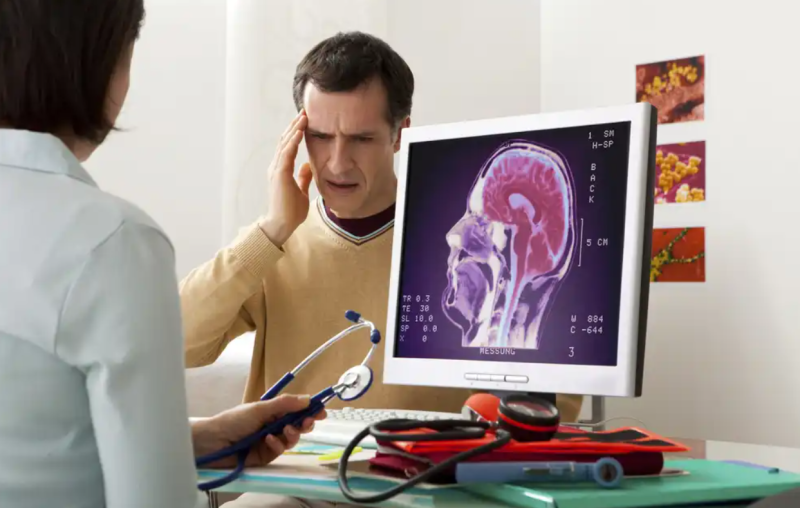
Currently, punctures in the head are one of the symptoms of most excellent medical consultations. They often manifest with such frequency and intensity that they cause alarm and restlessness in those who suffer from them.
In most cases, these punctures in the head can be linked to stress, colds, dehydration, and muscle spasms, among others.
Depending on the specific area of the head where they occur, they can be very mild, sharp, and intense. Some patients describe them simply as tightness in a head area that causes almost unbearable discomfort.
Currently, punctures in the head are one of the symptoms of most excellent medical consultations. They often manifest with such frequency and intensity that they cause alarm and restlessness in those who suffer from them.
In most cases, these punctures in the head can be linked to stress, colds, dehydration, and muscle spasms, among others.
Depending on the specific area of the head where they occur, they can be very mild, sharp, and intense. Some patients describe them simply as tightness in a head area that causes almost unbearable discomfort.
Tension headaches can occur when the fatigue has accumulated at the end of the day. Therefore, its primary triggers are poor rest, insomnia, hormonal changes, stressful situations, and a possible picture of depression.
Contents
2. Occipital neuralgia
According to some publications, occipital neuralgia, also known as Arnold’s disease, is another frequent reason for consultation in primary care services. This is characterized by the more significant occipital nerve inflammation, usually secondary to intense muscle contractures, especially in the trapezius and sternocleidomastoid muscles.
Symptoms include pinpricks at the back of the skull that may extend into the jaw or other craniofacial regions. The pain is also associated with a burning sensation, and the presence of sensory disturbances is not uncommon.
3. Focal migraine neuralgia
Localized migrainous neuralgia is nothing more than a migraine headache that occurs in intense outbreaks of pain focused around the eyes or in the temporal area. Experts from the Mayo Clinic explain that the pain is usually severe and long-lasting, so it is customary to interfere with everyday life.
Sometimes, this pain can be perceived as punctures and associated with an aura, that is, sensory disturbances that precede the seizures. This can occur after the sudden release of histamine or serotonin in the body caused by excessive consumption of alcohol or some medication, or physical activity. However, they are not the only causes.
It is also known as cluster headache or Horton’s disease. The severity of the picture is severe at times and can lead to mental health disorders due to repeated events.
4. Cardiac headache
Head sticks associated with cardiac headaches should be closely monitored to prevent future complications. In fact, according to a study published in the Spanish Journal of Cardiology, it is a commonly underdiagnosed condition.
This is considered a rare expression of coronary disease. It may be accompanied by nausea and worsen with exercise.
There are some other warning signs to look out for:
- The pain increases when bending over, coughing, or lying down.
- Difficulty performing specific movements or speaking.
- The ailment extends for more than three days.
- Seizures or blackouts are experienced.
- Fever, nausea, or vomiting.
Go to a medical consultation with a specialist if you experience one of these discomforts and, above all, if you suffer from vascular problems. Remember that prevention is the key.
5. Neck pain
 Another cause of head punctures that often goes unnoticed is neck pain. Minor accidents or bad postures cause this pathology. According to the experts from the Vall d’Hebron Hospital, its origin can be mechanical or inflammatory, the first being the most common and associated with sports activities.
Another cause of head punctures that often goes unnoticed is neck pain. Minor accidents or bad postures cause this pathology. According to the experts from the Vall d’Hebron Hospital, its origin can be mechanical or inflammatory, the first being the most common and associated with sports activities.
They are characterized by deteriorating the neck muscles and weakening the stability of the vertebrae. This, in turn, causes neck spasms that radiate pangs to different areas of the head.
6. Problems in ocular refraction
If the pinpricks on the head are felt mainly in the periocular region, it is likely a refractive problem. A publication from the National Eye Institute explains that it is a group of pathologies in which the visual image is not projected correctly on the retina, causing problems in seeing near (farsightedness) or far (myopia ). This causes blurred vision associated with a lot of eye fatigue and pain.
7. Sinusitis
Sinusitis is inflammation of the paranasal sinuses, usually in the context of an upper respiratory infection in which these typically air-filled spaces become congested with secretions. The most notable from a clinical point of view is the presence of stabbing pain in the facial region, associated with an oppressive sensation, and which is accompanied by non-specific symptoms:
- Sore throat.
- Runny nose.
- Earache.
- Cough.
8. Cerebrovascular accident (CVA) and transient ischemic attack (TIA)
Cerebrovascular disease has various forms of presentation, the most relevant being cerebrovascular accident (CVA). This can be ischemic (if a thrombus or embolus obstructed an artery and compromised cerebral blood flow) or hemorrhagic (if there was a rupture with bloodshed, sometimes a consequence of an ischemic event).
As explained by the Mayo Clinic, the symptoms are very varied and depend on the affected region. In general, they are motor disorders such as hemiplegia (inability to move one side of the body), aphasia (language disorders), impaired consciousness, and sometimes headache associated with nausea and vomiting.
Another picture is a transient ischemic attack (TIA), whose symptoms are similar but reversible. It also corresponds to an interruption of blood flow in a very short period, so it does not cause damage.
9. Brain tumors
The presence of a brain tumor causes various symptoms depending on its location, size, and growth rate. The most common benign tumors are meningioma and pituitary adenoma, while malignant tumors include glioblastoma and lymphoma.
These have some very particular characteristics. An investigation published in Universitas Medica evaluated a series of clinical elements related to diagnosing a brain mass in patients who went to the Emergency Department due to headaches. The authors determined these factors :
- Personal history of cancer (not associated with the nervous system).
- Worsening pain when specific movements are made.
- Motor problems (a type of neurological locality).
- Awakening at night due to pain.
Make changes to your daily routine.
Modifying your habits can help alleviate head pricks. For example, eat a healthy diet that includes fruits and vegetables. Also, a meal schedule can help you reduce episodes of headaches.
Keeping your body sufficiently hydrated is another factor to consider. Drink 2 liters of water a day to keep your health in tune. Also, avoid consuming products that contain caffeine and alcohol. Exercise frequently. With this, you will reduce stress and tension episodes that manifest as punctures in the head.
Also, you should avoid staying up late. Resting properly and sleeping the hours your body requires optimizes your daily performance and contributes to the disappearance of discomfort related to headaches.
If you manifest frequent punctures in your head, eyes, jaw, or lower part of the skull, go to a specialist. The health professional is indicated to rule out any pathology that may be considered necessary.
